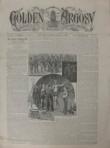AustLit
 124479600262697151.jpg
124479600262697151.jpg
Latest Issues
AbstractHistoryArchive Description
Generally regarded as the first pulp magazine, The Argosy was started in 1882 by Frank A. Munsey as a weekly magazine (in newspaper format) called The Golden Argosy. As with many other magazines publoished during the late nineteenth and early twentieth centuries its publication history became convoluted through name changes, mergers and publication restructuring.
The first significant change to the magazine came about in 1888 when its name was changed to The Argosy. When it became a monthly in 1894 Munsey developed a production style and format that effectively started the pulp revolution and in doing so cemented The Argosy as one of the most important magazines in American publishing history. In 1917 the magazine returned to being a weekly and two years later merged with Railroad Man's Magazine to become, briefly, Argosy and Railroad Man's Magazine,. Another change came about in 1920 when it was merged with another Munsey's title, All-Story Weekly, to become Argosy All-Story Weekly.
During a strange rationalisation of titles by Munsey's in 1929, Argosy All-Story Weekly was merged with Munsey's Magazine. They were separated soon afterwards, however, with Argosy All-Story Weekly continuing as a weekly. Re-titled Argosy on the masthead but with Argosy Weekly on the cover, the magazine concentrated on general/adventure fiction. Munsey's Magazine on the otherhand went fortnightly as All-Story and concentrated on love stories (it was subsequently renamed All-Story Love Stories, All-Story Love Tales and just All-Story Love).
Argosy continued as a weekly until November 1941 (absorbing All-American Fiction) along the way, when the frequency slipped to bi-monthly, and then, in July 1942, to monthly. The biggest change, however, came in September 1943 when the magazine stopped being an "all fiction" pulp magazine and shifted to a slick magazine with mixed content. Gradually over the following 35 years, the percentage of fiction decreased further and further and the magazine concentrated on becoming a 'men's magazine'.
Since the magazine was discontinued in 1978 there have been two further incarnations. A semi-professional version containing a considerable amount of science fiction ran for 5 issues in the 1990s, while another version, Argus Quarterly, was published intermittently between 2004 and 2006.
[Source: Galactic Central]
Notes
-
Contents page caption: America's Oldest and Best All Fiction Magazine.
Publication Details of Only Known VersionEarliest 2 Known Versions of
PeriodicalNewspaper Details
Has serialised
-
The Satyr,
single work
novella
science fiction
'All his days Professor Montague had sought the secret of life. Now he had found it–and horror beyond control!'
Source: Magazine blurb (Fantastic Novels).



